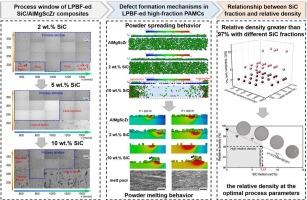On the defect formation during laser powder bed fusion of high-fraction SiC particle reinforced AlMgScZr composites
IF 4.6
2区 工程技术
Q2 ENGINEERING, CHEMICAL
引用次数: 0
Abstract
Laser powder bed fusion (LPBF) of SiC particle-reinforced aluminum matrix composites (PAMCs) is extensively utilized in aerospace and electronic device fields. High-fraction SiC-PAMCs exhibit superior intrinsic properties, but their mechanical performance is significantly compromised by defect formation. This study investigates the effect of SiC on the powder spreading behavior, melt pool characteristics, and defect formation during the LPBF of SiC/AlMgScZr composites. The results reveal a strong negative correlation exists between SiC fraction and the achievable relative density of the composites. Specifically, low-fraction SiC-PAMCs (≤2 wt%) achieve excellent powder bed homogeneity and melt pool stability, achieving relative density exceeding 98 %. In contrast, increasing the SiC fraction to 10 wt% induces severe powder agglomeration, which promotes the formation of lack-of-fusion defects and significantly reduces the relative density. This phenomenon originates from two aspects: powder spreading and fusion. The interplay between recoater blade-pushing force, interparticle cohesion, and friction, creating alternating agglomeration and cavity zones in powder bed. During laser processing, unmelted powder and SiC particle agglomerates are present within the agglomeration zones. While elevated laser power partially penetrates agglomerates, it cannot fully counteract agglomeration-induced defects. The critical fraction of SiC is 7.17 wt% under an acceptable relative density of 98 %. To break through the critical value, we recommend changes in powder mixing techniques, powder spreading strategies, and fabrication approaches. Within the current framework, this study provides qualitative guidance for practical production and establishes the foundation for further optimization of process parameters and composite design in LPBF-fabricated high-fraction PAMCs.

高分数SiC颗粒增强AlMgScZr复合材料激光粉末床熔合过程中缺陷的形成
SiC颗粒增强铝基复合材料的激光粉末床熔融(LPBF)在航空航天和电子器件领域得到了广泛的应用。高分数SiC-PAMCs具有优异的本征性能,但其力学性能明显受到缺陷形成的影响。本文研究了SiC对SiC/AlMgScZr复合材料LPBF过程中粉末扩散行为、熔池特征和缺陷形成的影响。结果表明,SiC分数与复合材料的相对密度呈显著负相关。具体来说,低分数SiC-PAMCs(≤2 wt%)实现了出色的粉床均匀性和熔池稳定性,相对密度超过98%。相比之下,当SiC分数增加到10 wt%时,粉末团聚严重,促进了熔合不足缺陷的形成,并显著降低了相对密度。这种现象源于两个方面:粉末扩散和融合。重涂机叶片推力、颗粒间凝聚和摩擦之间的相互作用,在粉床中形成交替的结块区和空腔区。在激光加工过程中,烧结区内存在未熔化的粉末和碳化硅颗粒结块。虽然提高激光功率可以部分穿透团聚体,但不能完全抵消团聚体引起的缺陷。在可接受的相对密度为98%时,SiC的临界分数为7.17 wt%。为了突破临界值,我们建议改变粉末混合技术,粉末扩散策略和制造方法。在现有框架下,本研究为实际生产提供了定性指导,并为进一步优化lpbf制备的高分数PAMCs的工艺参数和复合材料设计奠定了基础。
本文章由计算机程序翻译,如有差异,请以英文原文为准。
求助全文
约1分钟内获得全文
求助全文
来源期刊

Powder Technology
工程技术-工程:化工
CiteScore
9.90
自引率
15.40%
发文量
1047
审稿时长
46 days
期刊介绍:
Powder Technology is an International Journal on the Science and Technology of Wet and Dry Particulate Systems. Powder Technology publishes papers on all aspects of the formation of particles and their characterisation and on the study of systems containing particulate solids. No limitation is imposed on the size of the particles, which may range from nanometre scale, as in pigments or aerosols, to that of mined or quarried materials. The following list of topics is not intended to be comprehensive, but rather to indicate typical subjects which fall within the scope of the journal's interests:
Formation and synthesis of particles by precipitation and other methods.
Modification of particles by agglomeration, coating, comminution and attrition.
Characterisation of the size, shape, surface area, pore structure and strength of particles and agglomerates (including the origins and effects of inter particle forces).
Packing, failure, flow and permeability of assemblies of particles.
Particle-particle interactions and suspension rheology.
Handling and processing operations such as slurry flow, fluidization, pneumatic conveying.
Interactions between particles and their environment, including delivery of particulate products to the body.
Applications of particle technology in production of pharmaceuticals, chemicals, foods, pigments, structural, and functional materials and in environmental and energy related matters.
For materials-oriented contributions we are looking for articles revealing the effect of particle/powder characteristics (size, morphology and composition, in that order) on material performance or functionality and, ideally, comparison to any industrial standard.
 求助内容:
求助内容: 应助结果提醒方式:
应助结果提醒方式:


